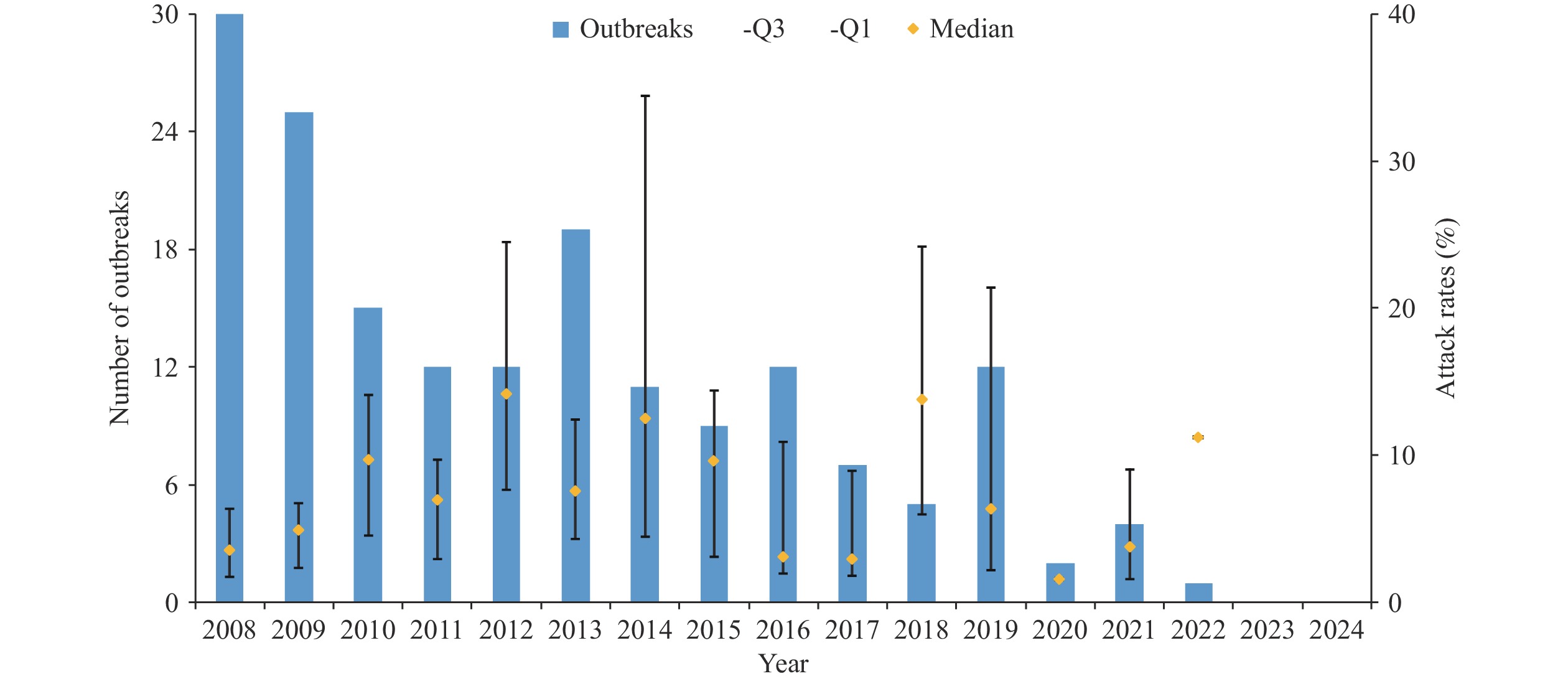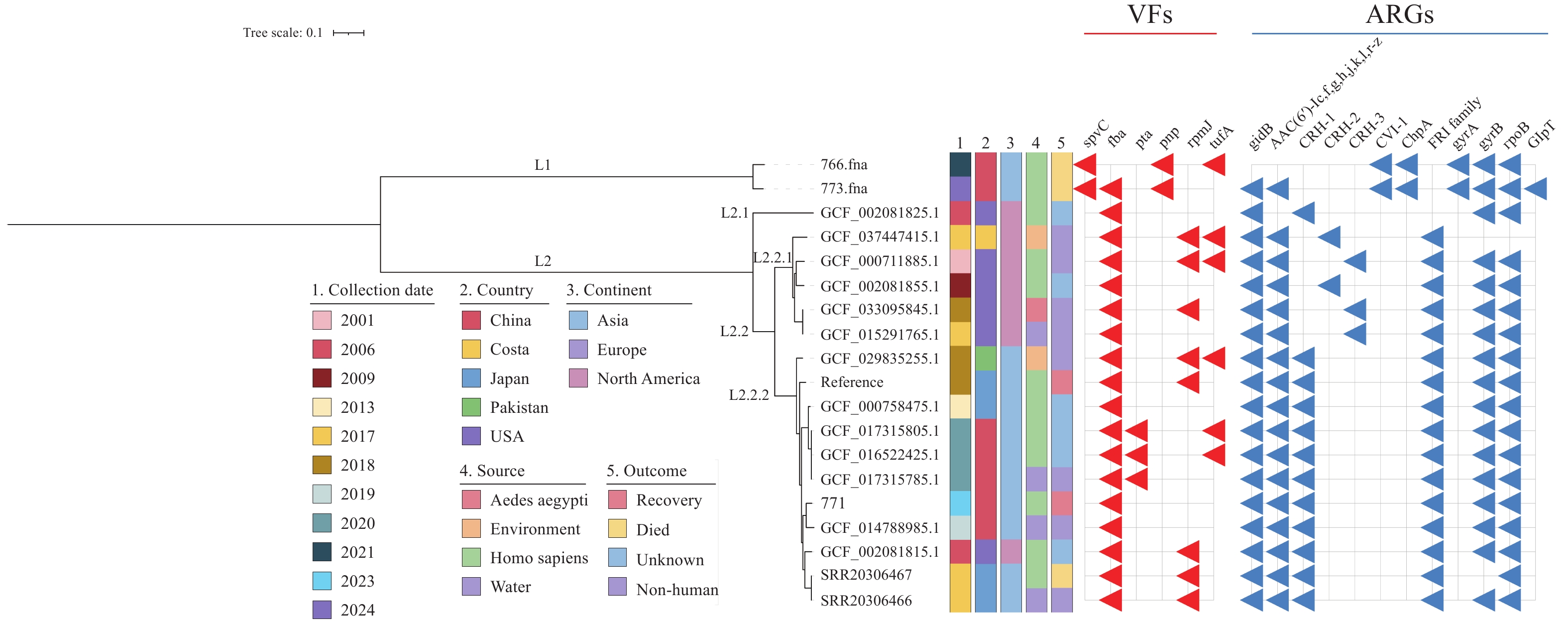2025 Vol. 7, No. 32
The incidence of bacillary dysentery (BD) has declined significantly in China, yet BD outbreaks persist across multiple regions. This study describes the epidemiological characteristics of BD outbreaks nationwide and proposes targeted interventions for outbreak prevention and control.
This study obtained BD outbreak data from the Public Health Emergency Event Surveillance System in China for descriptive epidemiological analysis and employed unconditional logistic regression to identify factors influencing outbreak magnitude.
During 2008–2024, China reported 176 BD outbreaks involving 9,854 cases and four deaths. The median attack rate and interquartile range for outbreaks were 5.99% (2.53%, 13.32%). Annual outbreak reports decreased throughout the study period, with no outbreaks documented in 2023 and 2024. Among all outbreaks, 75.6% occurred in rural areas, and 76.7% were reported in schools. Most outbreaks occurred during September or October (52.3%). Shigella sonnei and Shigella flexneri were the predominant outbreak pathogens; the principal transmission routes were waterborne (47.7%) and foodborne (23.9%). Median and interquartile ranges for response times and case counts were 3 (2, 6) days and 44 (25, 71) cases, respectively. Factors associated with larger outbreak size included S. sonnei as the causative pathogen, waterborne transmission, and outbreak duration of eight days or longer.
In China, BD outbreak frequency has decreased substantially. September and October represent high-risk months, with schools serving as the primary outbreak setting during the back-to-school season. Strengthening BD prevention and control in educational institutions, with particular attention to water and food hygiene, remains essential for outbreak prevention.
Carbapenem-resistant Klebsiella pneumoniae (CRKP) poses a major threat to global health. The co-production of multiple carbapenemases has emerged as a critical concern, further limiting the effectiveness of last-resort antibiotics such as ceftazidime-avibactam.
This study identifies an IncP6 plasmid co-harboring both blaKPC-2 and blaIMP-4 in a clinical isolate of K. pneumoniae. Comprehensive genomic analysis reveals a complex plasmid structure shaped by recombination events and highlights its potential for mobilization, underscoring the heightened risk of carbapenem resistance.
The emergence and diversification of plasmids co-harboring distinct carbapenemase genes highlight the urgent need for comprehensive genomic surveillance, stringent infection control protocols, and judicious antimicrobial management. These measures are essential to curtail the spread and evolution of multidrug-resistant organisms, which pose a substantial threat to public health globally.
Chromobacterium haemolyticum (C. haemolyticum) is an emerging multidrug-resistant and potentially extensively drug-resistant pathogen capable of causing invasive, lethal infections in humans. Conventional biochemical and mass spectrometry identification methods used in clinical laboratories cannot reliably distinguish it from C. violaceum.
This study provides the first report characterizing the genomic features of C. haemolyticum isolated from a young patient in China and reveals the evolutionary patterns of global C. haemolyticum isolates.
This research highlights the advantages of whole-genome sequencing for accurate differentiation of Chromobacterium species, raises public awareness about this uncommon pathogen, and provides scientific foundations for improved detection and prevention strategies.
Cholera, a severe diarrheal disease caused by Vibrio cholerae, remains a major global public health concern. In 2023, the World Health Organization reported 535,321 cholera cases and 4,007 deaths in 45 countries. Sporadic cases and epidemic outbreaks of the cholera serogroup O139 have been documented in various Chinese provinces since 1993.
This study analyzed the genomic features and antibiotic resistance patterns of 34 Vibrio cholerae O139 strains collected in Anhui Province between 2013 and 2024. The genetic sequences exhibited closer relationships to strains isolated from China than to those from India and Bangladesh, primarily forming two clusters. These strains contain multiple virulence factors, antimicrobial resistance (AMR) genes, and mobile genetic elements (MGEs). Notably, over 50% of the strains lacked the vgrG-2 gene in the type 6 secretion system (T6SS). Additionally, an increasing trend in azithromycin resistance was observed, whereas trimethoprim-sulfamethoxazole resistance showed a decreasing trend.
Vibrio cholerae O139 in Anhui Province displayed genomic diversity indicative of domestic origin rather than cross-border transmission. While their pathogenicity is limited, these strains demonstrate robust colonization capabilities and the potential to disseminate AMR genes. The shift in AMR profiles driven by the clinical use of azithromycin poses an ongoing transmission risk for O139 strains and may foster the further emergence of AMR in the region.



 Subscribe for E-mail Alerts
Subscribe for E-mail Alerts CCDC Weekly RSS Feed
CCDC Weekly RSS Feed


